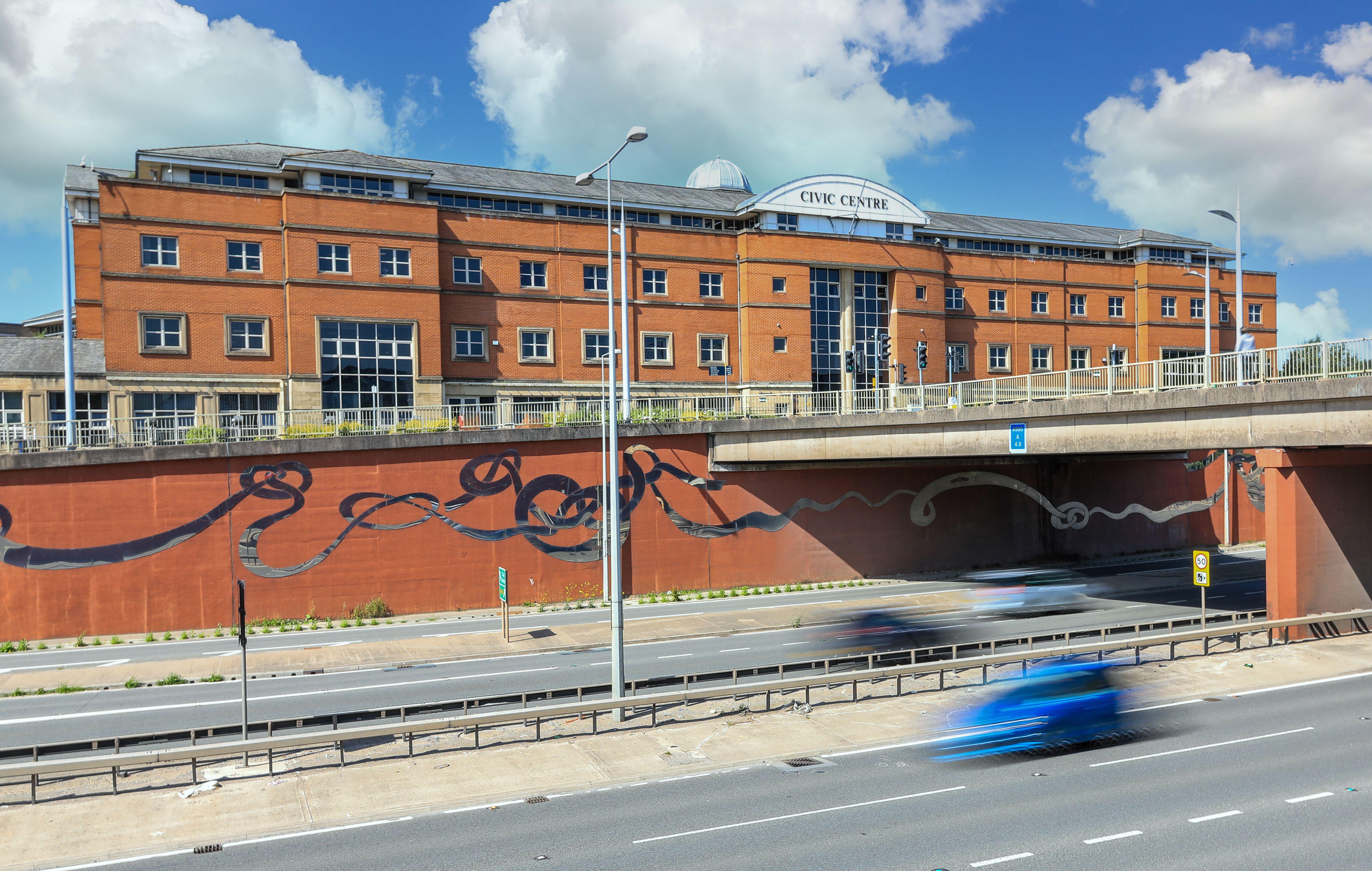Six towns, one city: The changing face of Stoke-on-Trent
Stoke-on-Trent's identity as both a city and the Six Towns can be confusing for non-Stokies. Here, Sarah, who directs the Six Towns Carnival, examines those identities as the area has changed over the decades
What comes to mind when you hear the word city?
In the UK, most consider cities to be a large area, comprised of residential areas of slightly varying degrees of 'niceness', people with shared accents and vernacular, all pulled together by a city centre with possibly a shopping centre, a retail park and the likes. The different areas of the city mostly speak to the catchment areas that determine what school your children will attend or your nearest doctor or what day your bins are collected, and there’s not a lot beyond those logistics.
Stoke-on-Trent is different; a city proudly known as The Six Towns; Longton, Fenton, Stoke, Hanley, Burslem and Tunstall. Growing up in the 90s, as a Fentoner, or Fentonian, I remember being rather put out to learn at primary school that Stoke-on-Trent was once known as the Five Towns because Fenton had been left out – for shame!
Not my beloved Fenton with its gorgeous park, the lido, bustling Thursday market and beloved Late Shop. Luckily some clever person soon rectified that, and we were up to the magic six.
I wasn’t just a strange child, by the way. I was not and am not alone in my town pride, whichever of the Six Towns you grew up in there was a real sense of local superbia and belonging that continues to this day.
This is a good point to stop and explain something for non-Stokies. Stoke is one of the central Six Towns of Stoke-on-Trent. We generally refer to the city and Six Towns simply as Stoke. It could get confusing. So, when people not from Stoke (city) ask us where we’re from or grew up we generally say Stoke (city) or Stoke-on-Trent, yet when fellow Stokies ask each other we’ll proclaim which of the Six Towns or surrounding areas because the distinction generally gives a sense of what type of Stokie you are, where you went to school and who you know. It may even bring out a slight sense of rivalry!
During the course of the interviews for this article, I enjoyed the chats and reminiscing with my fellow Stokies and it reminded me of things long forgotten. Such as my chat with Stacy from Stoke (the town, do keep up). Stacy fondly spoke about growing up on Selwyn Street, in Stoke, attending Boothen Primary School then Trent Valley High School – now known as Thistley Hough Academy.
She told The Stoke-on-Trent Lead: “I loved growing up around Stoke. I had loads of friends who went to the same primary school and we’d meet after school to play on the site of Stoke City’s old Victoria ground.
“We’d pretend it was a toxic waste ground and make dens. Back then you could roam for what seemed like miles and everyone knew everyone so you felt safe. If we got peckish we’d go over to Stoke town to the market and someone’s mum, nan or auntie would be there to buy us a Wright’s sausage roll or chips.
“We were all so close that even when we went up to high school we’d still hang around but obviously by then we’d be outside the old Victoria Wine, seeing if someone who looked old enough would grab us a bottle or two of Lambrusco after we’d pooled our pocket money together!
“Even when we left school and went to town (Hanley) clubbing, the Stoke lot or Westenders as we were known still hung out in the same groups and used to have little dust ups with the kids from Hanley, Shelton and Birches.
“It was nothing too serious, we just felt protective and were a bit territorial I suppose. It’s really sad to look at Stoke town now and see all the old shops and market stalls more or less gone. It started even before the pandemic but I guess it's much worse after. I don’t know what the future holds for Stoke as one of the Six Towns, it seems like most old buildings are being knocked down or converted into student accommodation or flats so that doesn’t bode well for local businesses as most students or commuters tend to go to the bigger retail parks in the city or out of town. The sense of community has pretty much left now”.
Stacy’s story appears to be repeated across the Six Towns. I spoke to June Cartwright - also known as The Queen of Burslem. June is a great-Grandmother and maternal figure, being involved in many community projects and initiatives in Burslem.
She told The Stoke-on-Trent Lead: “Burslem is called the Mother Town because of the start of the potbanks began there - including Wedgwood.
“So it was through the birth of potbanks, she became the Mother. Underground, on market place is the first Wedgwood pottery called Ivyhouse. The loss of potbanks is the worst thing to happen to Burslem, greedy owners sold the factories including Doultons to be made into cheaper pottery.
“Of course, that led to the loss of shops and markets. The pubs and restaurants now are award-winning, thank goodness, so we still have some local businesses.
“Since converting business parks like Forest Park etc shops have really struggled. Jane Ashworth of Labour, as council leader is doing a really good job. She does her job of sorting our town out – litter picking, road repairs and the stuff that people feel is important - she is well-liked.
“We still have fantastic historic buildings that people come from miles to see and we, of course, are the home of Port Vale FC. It helps lots of businesses and local organisations. Despite the loss of local shops and businesses our fantastic community still comes together for summer fetes and Christmas markets, held in the Square”.
Speaking with June put me in mind of how Burslemers are seen as the “proper Stokies” and are agreed to have the strongest Potters accent. I’d forgotten the title “The Mother Town” but it’s clear when you see how central and historic Burslem still is to this day how the effects of the potbanks and factories shutting down is still contentious and a loss of town identity to many.
J F Burgess is a local author and grew up in the town of Hanley. He spoke of a time when the town used to attract buses of visitors from Birmingham and Manchester looking for a night out.
He told The Stoke-on-Trent Lead: “In the 80s and 90s, Hanley's nightlife was the heartbeat of the towns’ night-time economy. Iconic clubs like The Place, Chicos, Satchmos and Golden at the Academy, the latter attracting busloads from the West Midlands and Manchester, hosted world famous DJs, featured on MTV and in numerous sub-culture magazines of the day.
“The pubs and curry houses of Hanley were not just restaurants and watering holes; they were communal hubs where friendships were forged and stories shared. The Arzoo, Monzil, Shaffers, Dew Drop Inn, Leadbelly’s, Flickers, Heaths Wine Bar, The French Horn, Minstrels, and Left Bank Café (a bar I DJ’ed at for a couple of years), were all the backdrop to countless anecdotes and camaraderie that defined the social fabric of the town as young and old happily mixed.

Westwood Mills, Lichfield Street, Hanley, Stoke-on-Trent, Staffordshire, 1965-1968
“However, as the years progressed, Hanley underwent a transformation that was hard to accept. The once-thriving establishments began to show signs of neglect and decay, a reflection of the local governments’ failure to invest in the towns’ infrastructure and cultural preservation. The consequences of underinvestment became increasingly apparent.
“Once-vibrant venues struggled to compete with neighbouring cities, and the palpable sense of community began to wane. The neglect of essential services and cultural assets left Hanley's soul bitterly bruised; a stark departure from the lively town of my youth.
“Hanley's journey is a poignant reminder of the profound impact that awful local government decisions can have on the essence of a community. Bulldozing buildings is not progress if nothing of value replaces them!
“Any local will tell you: the outgoing government has spent millions of so-called levelling-up funds on all the wrong things: unwanted car parks and council buildings - vanity projects that were never going to increase footfall, leaving the city teetering on the edge of bankruptcy in 2024.”
Speaking with both June and Stacy makes it clear that through the changing economic climate, the Six Towns are still remembered for not only the historic Potteries but also the nostalgia that only comes from growing up in industrial-led communities. There’s an authenticity and unaffected nature in the descriptions of their beloved towns and their precious memories. Burgess’ detailed description further reinforces the importance of local businesses as opposed to national chains, in the role of what gives local towns and communities their essence.
The people of the Six Towns, though extremely proud and sentimental about their own particular town, are still one city. And yes, though people may have lived slightly more insular lives growing up – going to a local school, shopping and hanging out on the local high street, when the time came to spread your wings it was important to have a city centre – one point of “big night’s out” or shopping on payday.
The issues that have led to the loss of character and community are citywide and all rather aligned. Local businesses and attractions traded in place of things that nobody seems to want. I don’t believe this is simply a matter of people not wanting to move with the times or a misguided nostalgic blindspot. People of the Six Towns miss the nuanced features and characteristics that made their town.
The rivalries between the towns were always just essentially Stokie in-jokes that really just spoke to our personalities – down to earth, fun loving and quite sociable people. In essence, the separatism of the Six Towns is actually what brings people together as the one city.
When city councils make decisions, they need to take all of these factors into account. Quite often decisions are made in an attempt to regenerate cities like Stoke with the intention or promise of bringing in outside investment. However the things that are removed to make space for the new and shiny additions are often what makes the city standout.
It has to be a case of balancing what the residents are proud of and want to keep, with what will enhance those features. The pride and fondness that people feel for their towns can surely translate into an attraction in itself, should there be a more creative approach to investment. A one-size fits all approach to regeneration will never be the way forward for somewhere like Stoke where it may well be one city but is also every bit as much Six Towns.
You can see the previous newsletter we sent to our subscribers here
Sarah is founder and co-director of Staffordshire Association For Black Lives Equality CIC (SABLE). Sarah works on many collaborative projects and initiatives, specialising in inter-hierarchical models of engagement to ensure equitable pathways and practices. Sarah is from Stoke-on-Trent and directs the city’s largest free event - the Six Towns Carnival.
The Lead is now on Substack.
Become a Member, and get our most groundbreaking content first. Become a Founder, and join the newsroom’s internal conversation - meet the writers, the editors and more.





